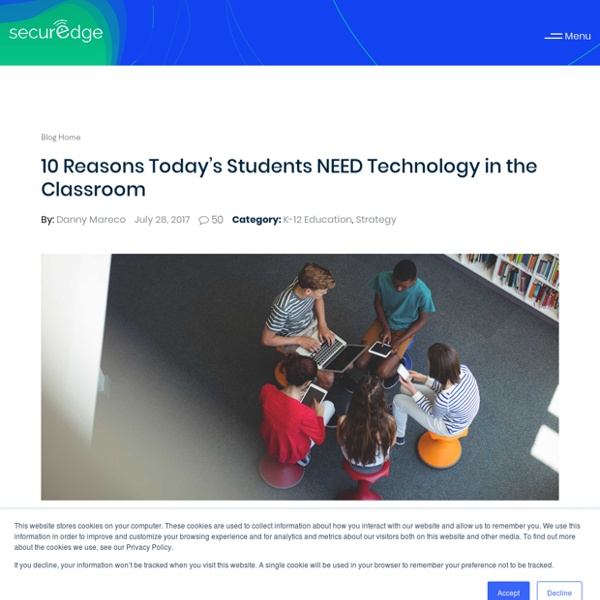Action mapping: A visual approach to training design
Action mapping is a streamlined process to design training in the business world. Its goal is to help designers: Commit to measurably improving the performance of the businessIdentify the best solution to the performance problemWhen training is necessary, create challenging simulations, not information presentations I created the process in May 2008, when I was designing custom elearning for corporate clients (here’s the first blog post about it). The following slideshow gives a simplified, very high-level overview.
8 Technologies That Will Shape Future Classrooms
What does the future of learning hold? What will classrooms of the future be like? Emerging technologies such as cloud computing, augmented reality (AR) and 3D printing are paving the way for the future of education in ways we may have yet to see.
How Education And Technology Are Evolving Together
What will education and learning look like ten years from now? originally appeared on Quora: the place to gain and share knowledge, empowering people to learn from others and better understand the world. Answer by Mike Silagadze, Co-Founder and CEO at Top Hat, on Quora:
Integrating Technology with Bloom’s Taxonomy - Teach Online
Creating authentic learning experiences for students is an essential element in online course delivery. Through recent discussion instructors have inquired “How do we provide meaningful learning experiences for students using tools that are intrinsically motivating?” 2 Questions as such imply the need to provide instructors with “. . . innovative ways of integrating technology that encourage higher-order thinking skills.” 2 Research indicates that “Today’s students, regardless of demographics, have shown an interest in digital opportunities to learn, and the range of Web 2.0 tools that make collaboration, innovation, and individual exploration possible is incredible.” 2 Practitioners within the field of education have thought of unique ways to connect digital tools with the framework of Bloom’s Revised Taxonomy, which has led to the emergence of a Digital Bloom’s Taxonomy.
What is an Infused Classroom?
What is an Infused Classroom? Join the conversation about this post in our Facebook Group – with a community of amazing educators. In an Infused Classroom, the teaching and learning outcomes are the most important aspect, and technology simply enhances an already purposeful learning environment. In this classroom or school, we seek to better understand our students as learners and empower their learning journey. Infused Classrooms, and thus Infused Teachers, combine both great pedagogy and technology, but only when it will make the learning stronger.
Gaining Support for Blended Learning
In November, I was fortunate to have the opportunity to visit several schools that are personalizing learning for students through blended learning models. The technology allows for a flexible environment where students can learn at their own pace and in their own way. Teachers have more time to work with individuals and small groups while other students are learning content online or working on projects. After several days of visits to schools at all levels, it become clear to our team that there isn’t one formula for success. Each school had a story to tell about how they had launched initiatives and then iterated or pivoted after getting feedback and analyzing results. The one common theme at each school was that everyone was on board with the initiative and committed to meeting the needs of all students.
The WannaCry Virus: What It Is and How to Remove It
Don't cry: If you've installed Microsoft Windows updates, you're considered safe from an attack by the infamous WannaCry virus. But if you haven't been vigilant, you might need to worry. A variant of WannaCry is known as WannaCrypt. WannaCry affects Windows computers, specifically Windows Vista, Windows 7, Windows 8.1, Windows 10, Windows Server 2008, Windows Server 2008 R2, Windows Server 2012, and Windows Server 2016. What Is the WannaCry Virus? This ransomware exploits vulnerabilities in Microsoft Windows Server Message Block (SMB) protocol.
25 Easy Ways to Use Technology in the Classroom
Although many technology-based teaching methods and resources effectively engage students and build their skills, many educators encounter difficulties when using technology in the classroom. Maybe a specific platform is too hard to introduce. Or maybe it won’t run on your devices. Despite the challenges, you likely want to enjoy the benefits that education technology can deliver.
Why do we need technology integration in education?
Technology in education mirrors the fast-paced world we live in. In modern classrooms, it’s rare to find students all working on the same exact activity. Instead, today’s schools are technology-rich learning spaces that promote diverse activity.
Why do we need technology integration in education? - Classcraft Blog - Resource hub for schools and districts
Technology in education mirrors the fast-paced world we live in. In modern classrooms, it’s rare to find students all working on the same exact activity. Instead, today’s schools are technology-rich learning spaces that promote diverse activity. They’re abuzz with collaboration, critical thinking, creativity, and communication, all thanks to technology. Ask an administrator about using technology in the workplace, and you might hear about edtech as a tool for going about the business of school.



